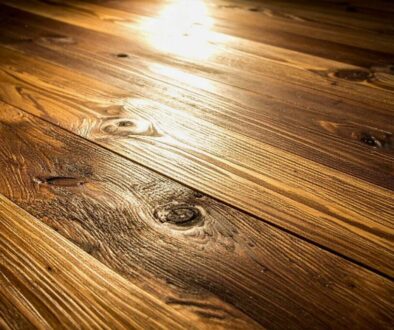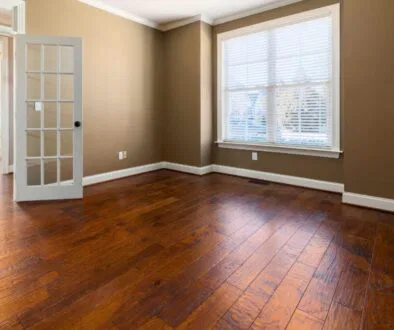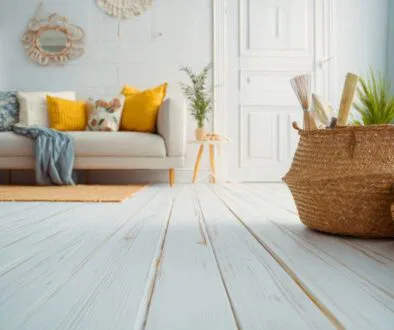Glued Down vs. Floating Wood Floor: Which is Better?
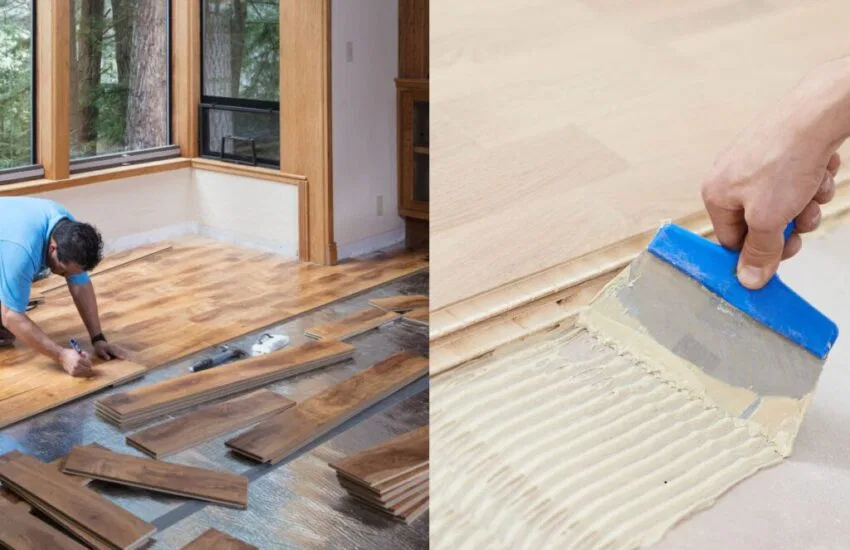
Published on June 12, 2024
Choosing between a floating wood floor and glued-down flooring can be a challenge. Each type of flooring installation has its pros and cons. But one will most likely suit you better.
So, how do you know which type of floor installation is more to your taste?
Well, that’s what this post is about. Here’s a side-by-side comparison between a floating wood floor and glued-down flooring.
What is a Floating Wood Floor?
As its name suggests, a floating wood floor is a type of flooring installation that floats over your existing floor. Unlike traditional flooring, a floating wood floor doesn’t use nails or adhesives.
Instead, the wooden floor planks are secured using a click-and-lock system where the grooves are designed to interlock together without fasteners.
Floating Wood Floor Advantages
1. Easy to install
When I said that a floating floor uses a click-and-lock system, that’s how it’s installed. You just slide the floor planks beside each other until you hear a click, and voila, the planks are secured.
There’s no need to hurt your fingers, hammer nails or apply any adhesive. This makes it one of the easiest ways to install a floor, not to mention, it’s a lot cheaper since you don’t have to buy nails or wood glue.
2. Durable
Since floating wood floors are made up of interlocked sheets of hardwood, they offer better durability. Besides, the wood planks aren’t attached to your subfloor. So the moisture can’t easily seep into the wood, making it less prone to rot and decay.
3. No toxic chemicals
Wood glues and adhesives contain formaldehyde and phthalates.
Formaldehyde is a toxic substance that’s been linked to various types of cancers. It’s also posited to cause cellular damage, which can affect our neurological and developmental systems.
While phthalates is an umbrella term for a group of chemicals used to make plastic. According to the CDC, some types of phthalates can cause real damage to our reproductive system.
Since installing a floating wood floor doesn’t involve handling adhesives, you won’t have to worry about exposure to these toxic chemicals.
4. More comfortable on the feet
The space between your subfloor and the hardwood planks creates a cushion for your floor. As such, floating wood floors are easier on the feet than traditional floor installations.
Floating Wood Floor Disadvantages
1. Prone to buckling and warping
If your area often experiences high humidity, a floating wood floor may not be the best choice.
As you know, wood contracts and expands depending on its environment’s moisture level. If you live in a humid area, moisture can accumulate in the pocket of air between your subfloor and the wooden floor planks. This can cause the planks to expand and contract, causing them to buckle and warp.
This can, however, be avoided with proper underlayments.
2. Needs regular maintenance
In traditional flooring installations, the floor planks are directly against the subfloor. Thus, the ground bears most of the load on your floors, such as furniture and people walking on it.
However, in a floating floor installation, the wood planks have to absorb all the load, which is why they tend to indent over the years.
Removing and replacing your floating floor is pretty easy, though, so this isn’t really much of a concern.
3. Noisy
Floating wood floors tend to amplify sounds, so if you’re planning to install one in the nursery or your home office, you might want to reconsider your flooring choices.
What is a Glued Down Flooring?
Gluing down floor planks is a traditional way of installing a wooden floor. As the name suggests, it sticks the floor to the subfloor with adhesives. The planks are set firmly on the concrete subfloor when the adhesive dries.
If you’re using engineered wood or vinyl, there are two ways of gluing a floor down: hard-set or pressure-sensitive.
Hard-set glued flooring involves applying adhesives to the concrete subfloor and sticking the planks on it until the adhesive sets. Pressure-sensitive glue-down flooring, on the other hand, uses a peel-and-stick technique. The planks already have adhesives on the back, and all you have to do is peel the protective covering and stick it on the subfloor.
Glued Down Flooring Advantages
1. Fixed
Since the wood planks are glued to the subfloor, it doesn’t shift as much as that of a floating wood floor. It also feels firmer on the feet and you won’t feel that annoying sensation of the floor shifting beneath you.
2. No need for a vapor barrier
In glued-down flooring, the glue itself acts as the vapor barrier. So there’s no need to buy and install underlayments.
3. Doesn’t make a lot of noise
Because the floor planks are fixed, so they don’t tend to creak when walking on. This makes them perfect for spaces where silence is required like your nursery, bedroom, or home office.
Glued Down Flooring Disadvantages
1. More difficult to install and remove
Installing and removing glued-down flooring typically requires a skilled professional. You can try to do it yourself, but if you don’t have extensive floor installation knowledge, it can be messy.
Besides, this installation method requires working with strong adhesives, which can be a health hazard if you’re not careful.
2. Costly repairs
As mentioned, removing a glued-down floor can be difficult and typically requires a professional. So, when it needs replacement or repair, it can be costly.
Floating Wood Floor vs. Glued Down Flooring
At the end of the day, it all boils down to your personal preference. As I’ve said, each floor installation type has its pros and cons.
If your budget is tight or you want to do it yourself, a floating wood floor will be more practical. But if you don’t care for creaking noises or shifting floor planks, a glued-down floor is your best bet.
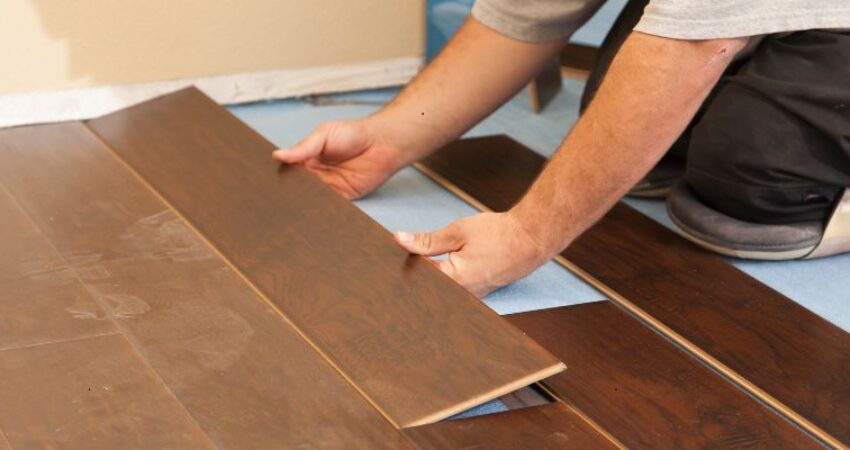
Frequently Asked Questions (FAQs)
Are floating wood floors good?
Floating wood floors are a popular choice due to their versatility and ease of installation. They provide a stable and durable option that can enhance a space’s aesthetic appeal. Additionally, they can offer good sound insulation and are often more budget-friendly than other flooring options.
How long do floating wood floors last?
Floating wood floors can last 20-30 years or more with proper care and maintenance. Factors like quality of materials, installation, and foot traffic play a role in determining their lifespan. Regular cleaning and prompt repairs can help extend the floor’s longevity.
Can you walk on floating floors?
Yes, you can walk on floating floors as they are designed to withstand regular foot traffic. Ensure proper installation and follow maintenance guidelines to preserve their durability and appearance over time.
Final Thoughts
The choice between glued down and floating wood floors ultimately depends on various factors such as installation ease, budget, maintenance preferences, and desired aesthetic. While glued down floors offer stability and a seamless look, floating floors provide versatility and easier replacement options.
Consider your specific needs and preferences to determine which option aligns best with your lifestyle and design goals. By weighing these factors carefully, you can make an informed decision that ensures long-lasting satisfaction with your chosen wood flooring solution.
Hire The Timber Experts For Your Next Project
Vintage & Specialty Wood should be your source of the highest quality timbers from around the world. When it comes to fabricating and installing reclaimed wood or specialty wood products in your home, we don’t cut corners. We offer many reclaimed wood and specialty wood products such as Douglas Fir, white oak, and much more. We also offer timber framing and wood flooring services as well. Contact our team today to speak to a timber expert about what Vintage & Specialty Wood can do for you.

This Blog Is Fact Checked
This content has undergone meticulous fact-checking by our team of internal experts. Gain a deeper understanding of the high editorial standards we uphold on our website here.

About The Author
Experience, exploration, and knowledge are the hallmarks of writer Rei Bayucca. Her dedication to crafting articles that both inspire and educate will leave you thinking long after you’ve finished reading.

